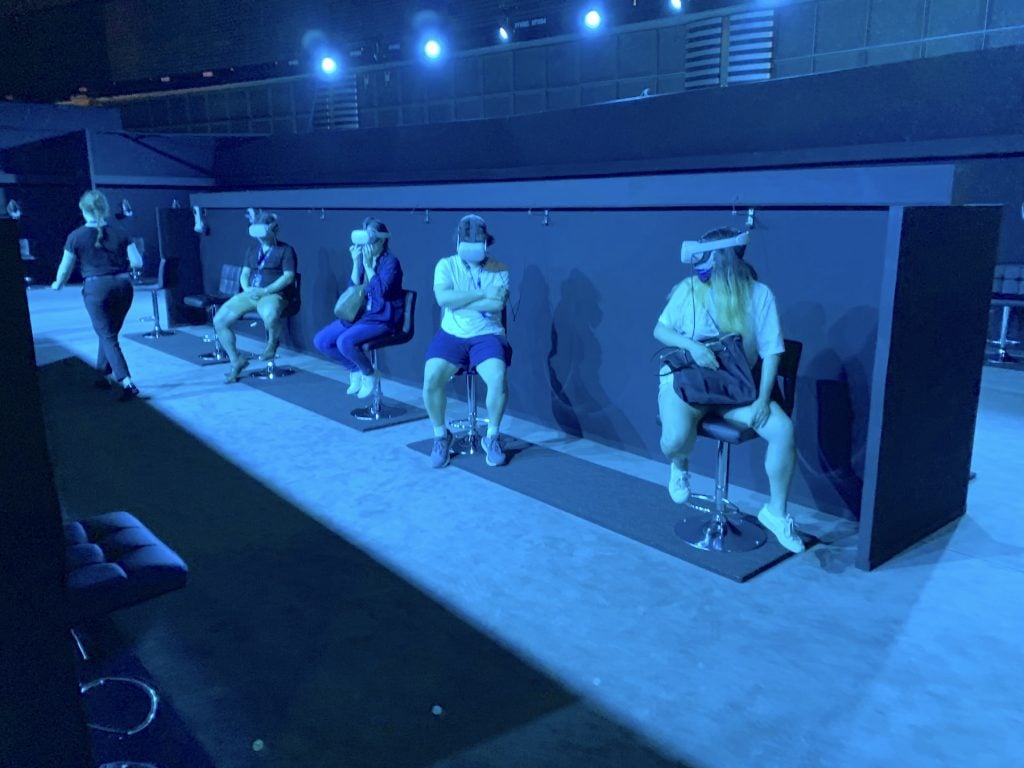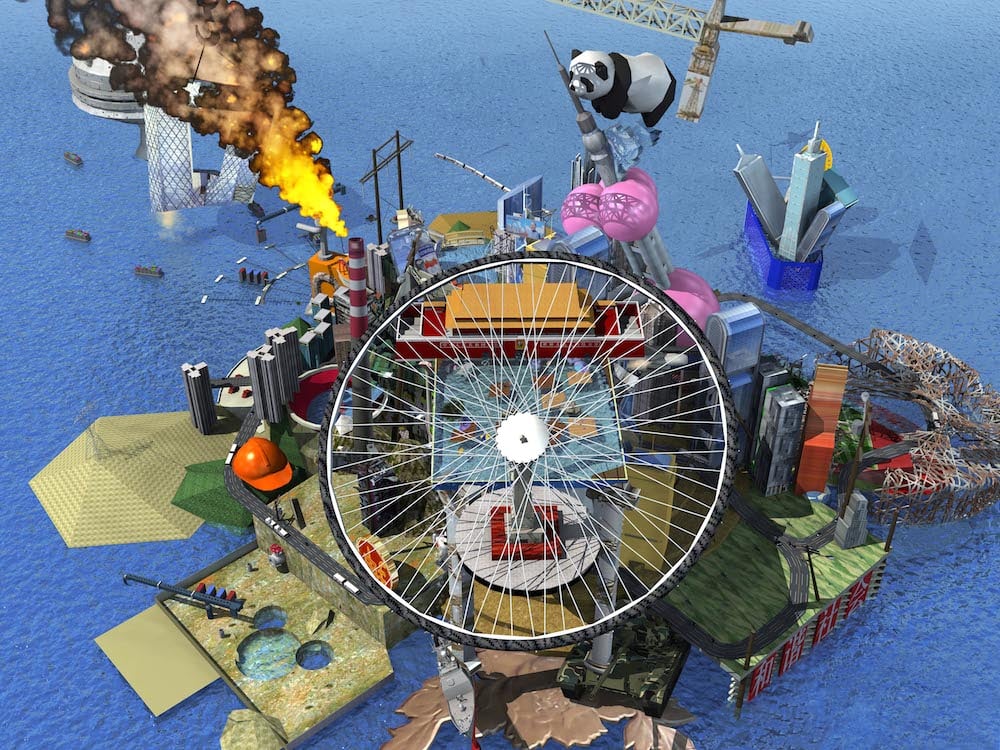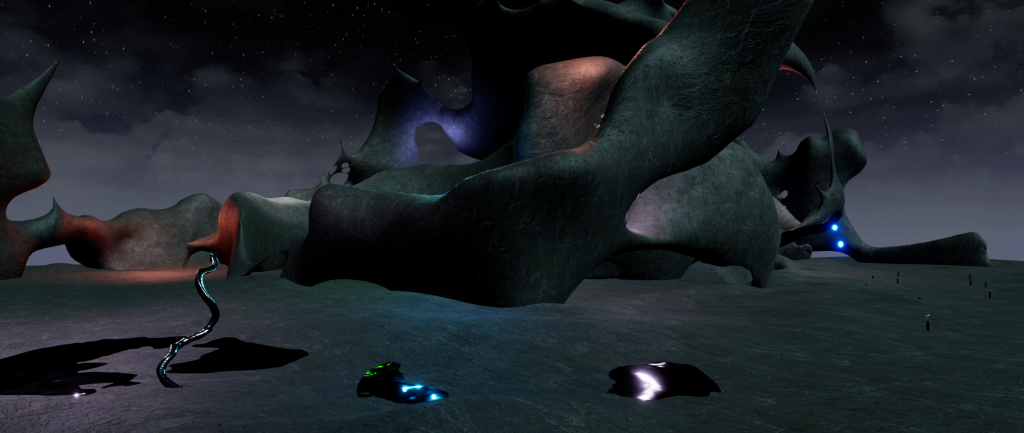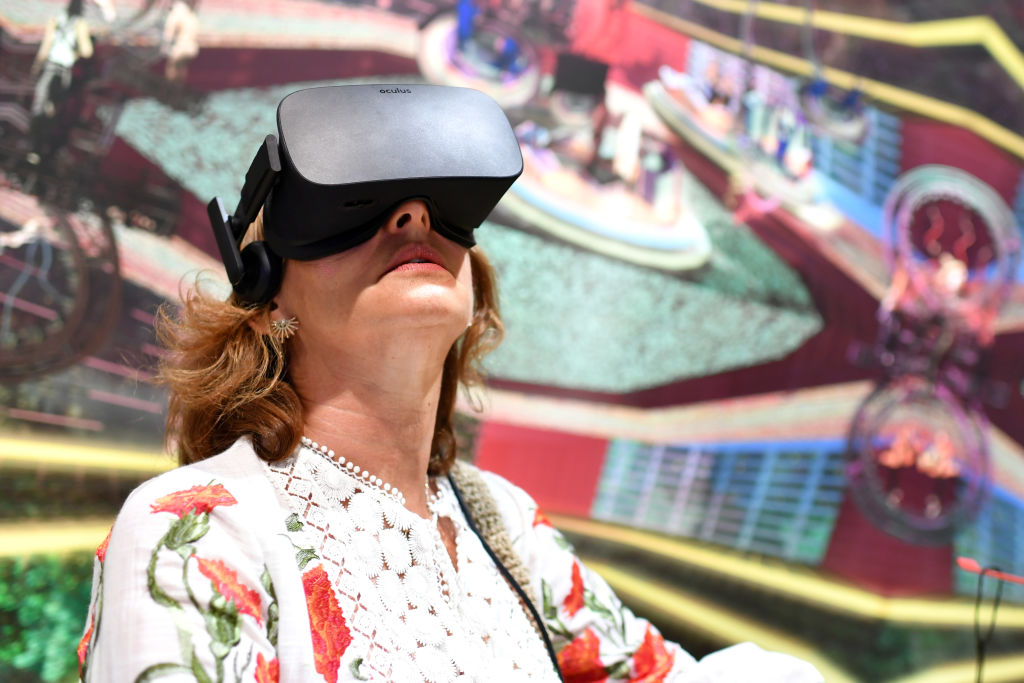Every Wednesday morning, Artnet News brings you The Gray Market. The column decodes important stories from the previous week—and offers unparalleled insight into the inner workings of the art industry in the process.
This week, a hard look at what’s hiding in plain sight…
TECHNO-LOGIC
As demand for cryptocurrencies and NFTs continues melting down like so much physical infrastructure during this scorched-earth summer, conversations about the metaverse have kept marching forward unperturbed. Proponents of the concept maintain that a fully immersive, socially connected virtual world will alter every aspect of the way we live, including the types of art and culture we care about most.
But built into this (allegedly) optimized vision of the metaverse is an aggressive sales campaign for new hardware and software developed by select providers. Unless we recognize this campaign for what it is—self-interest masquerading as necessity—a significant part of art’s future will be shackled even tighter to an endless cycle of pricey devices, paid subscriptions, and product updates than it already is in the smartphone era.
Let’s start with a few reference points to ground this discussion. In late June, Mark Zuckerberg personally demoed several new prototypes in Meta’s line of virtual-reality (V.R.) and augmented-reality (A.R.) headsets, which he touted as “a big step forward toward realism” in immersive experience. A few days later came the launch of the Metaverse Standards Forum, a consortium of more than 50 companies (and counting) collaborating on universal guidelines to ensure every participant’s virtual contributions will be compatible with one another in an online world bridging the personal and the professional.
Mid-July saw Paris host the Metaverse Summit, a two-day convention featuring more than 200 speakers from across the startup, venture capital, art, gaming, and influencer realms. The event seems to have had a fair amount of crossover with the latest edition of NFT.NYC, where only three weeks earlier, crypto’s supposed centrality to a shared virtual world-to-come was a frequent topic.
Rounding out the recent milestones is the release of venture capitalist, former Amazon Studios executive, and writer Matthew Ball’s book The Metaverse: And How It Will Revolutionize Everything, which I suspect will be hard for people even tangentially engaged with this subject to avoid in the weeks ahead. (Case in point, Ball recently adapted some of the book’s core ideas into a cover story for Time magazine, quite possibly the last media vertical I would choose as an avatar of the digital avant-garde if not for its out-of-nowhere bump and grind with NFTs.)
It would be wrong to say that every person involved in the above projects thinks identically about the metaverse. However, most of them are responding to the same emerging consensus about what the concept means: exactly the kind of mass-participatory, 3D-modeled, optically immersive digital world that Zuckerberg summarized as an “embodied internet” shortly after rebranding his company in pursuit of its manifestation last fall. The consensus tacitly accepts the premise that this type of metaverse is the only one that qualifies for the label and the only one that is worth building (as I covered a few weeks ago).
The problem is that this line of thinking necessarily zips right past a vital reality: Expand your conceptual horizons just a bit, and it can be credibly argued that we’re already in the metaverse—and have been for years. Believing otherwise sets us up to pay, literally and figuratively, for a future dictated to us by the entities with the most to gain. That outcome would drastically constrain the horizons of art, artists, and art enthusiasts everywhere.
Much of the rest of this column pulls from interviews I conducted for the July 28 episode of the Art Angle podcast, which will be an explainer on the metaverse and its impact on art. We’ll cover a lot more ground there. For now, though, let’s focus on the salesman’s agenda inside the iteration of the metaverse now driving the mainstream conversation.

Visitors enjoy the virtual reality component of “Van Gogh: The Immersive Experience.” Photo by Ben Davis.
THE HARD PROBLEMS OF HARDWARE
Zuckerberg’s demo of Meta’s headset prototypes offers a way into the twin dilemmas of his (and Silicon Valley’s) preferred metaverse. Crucially, the four headsets are, to use his own words about the project codenamed Butterscotch, “nowhere near shippable.”
Meta also decided earlier this summer to keep version one of its long-in-development augmented-reality glasses (codenamed Orion) off the mass market, reinforcing that a metaverse delivered through the company’s own hardware is still largely a matter of potential. The dynamic is all the more notable since Zuckerberg predicted in 2015 that smartphones would be phased out in favor of wearable devices by 2020.
None of Meta’s competitors seem to be much closer to rolling out actual products fit for the type of always-on use envisioned by metaverse power-brokers. Ball said in a recent interview, “This technology problem is extraordinary… Just solving for optics and battery currently far exceeds our grasp.” For example, Snapchat’s Snap Spectacles (strictly available to developers as of my writing) have to be recharged after just 30 minutes and “augment less than 10 percent of your view” at one-quarter of the resolution and frame rate believed to be necessary, according to Ball.
Add effective wireless chips and advanced computer processors, and the challenges only mount. Weight is a serious issue; one of Meta’s latest headset prototypes had to be flanked with chunky handles so that users could support the bulk. Then there’s the matter of the excessive heat: Just think of how toasty the average laptop gets after a few hours of dedicated use. Now imagine the laptop is wrapped around your face. Want in on that vision of the future of art and culture?
So, the headsets and handsets currently available from Meta and others are good enough for limited recreational use, but they’re still light years away from practical application. This is where we are 35 years after the advent of virtual reality as a term and as a high-end commercial product (both courtesy of tech pioneer Jaron Lanier and collaborators).
This is just one reason why the alternate possibilities are so important to consider. Neal Stephenson, the programmer, developer, and sci-fi author who coined the term “metaverse” in his 1992 dystopian novel Snow Crash, made waves earlier this year when he announced his involvement in a blockchain-centered metaverse startup called Lamina1. The news was especially seismic after Stephenson (who previously worked on Microsoft’s A.R. hardware) explained on Twitter that Lamina1 would eschew exactly the type of V.R./A.R.-driven iteration of the metaverse that he dreamed up in the pages of Snow Crash.
Why? Path dependence, or the tendency for the next choices we make to be heavily influenced by the decisions that have led us to the present. Stephenson admitted that what he “didn’t see coming” while writing the book were decades of video games that would condition humans to interact with 3D-modeled graphics via 2D screens and hand-operated accessories. But now that they have, ignoring that fact would be a colossal mistake for anyone trying to develop the next digital frontier.
Future generations aren’t exactly going a different way, either. Ball notes that a staggering three-quarters of children between ages nine and 12 in the U.S., U.K., Canada, New Zealand, and Australia are on Roblox, the kid-centric shared 3D world exclusively run on flat screens. As important as this technological dynamic is, though, it’s only an introduction to an even more crucial conceptual distinction.

Cao Fei, RMB City – A Second Life City Planning (2007). Photo: Courtesy of MoMA PS 1.
“THE FUTURE IS ALREADY HERE”
Wagner James Au, author of the forthcoming book Why the Metaverse Matters and a chronicler of virtual worlds since the early aughts, largely agrees with Stephenson’s original vision of a metaverse, just not a hardware-dependent one. He sees the ultimate iteration of the concept as an immersive virtual world accessible by millions of avatar-instantiated users and integrated with the real economy. But he also believes the true lifeblood of the concept is social.
“A lot of technologists treat the metaverse concept as simply a technology problem when actually it’s about creating an online society, an online world that people can thrive in”—an environment where they can “meet other people and collaborate creatively with them,” he said.
The notion of a metaverse as a virtual space that is primarily social has come up again and again in my conversations with scholars, artists, and curators deeply engaged with tech and culture. As soon as you accept the idea that the true currency of a shared virtual world is relationship-building, it fractures the increasingly mainstream conceit of a metaverse that can only be ferried to us once the right advanced technology is available in stores. Just ask Tina Rivers Ryan, curator of modern and contemporary art at the freshly rebranded Buffalo AKG Art Museum (formerly the Albright-Knox Art Gallery) and co-curator of the institution’s recent exhibition “Difference Machines: Technology and Identity in Contemporary Art.”
“In many ways, we’re already living in the metaverse, right?” she said. “I met my husband on the internet… I met many of my best friends on the internet. I’m in daily group chats with people who are only known to me through the internet, who I’ve never met IRL, and those relationships are as meaningful to me as the ones I have with, like, my oldest friends.”
Ryan—for my money, one of our most incandescent thinkers on the merging of art and tech—is supported by more than just personal experience. The most recent Consumer Trends report from journalist Dan Frommer and early-stage investment fund Coefficient Capital found a dramatic difference in how respondents of different generations met their closest friends. Only three percent of Boomers in the sample pool said they made these vital social connections online. That share rose to 19 percent among Gen X respondents, nearly 40 percent among millennials, and 34 percent among zoomers.
It’s just one example of how people in these age groups (myself included) have spent most or all of their lives so immersed in virtual exchanges that drawing a bright line between “online” and “offline” borders on silliness. (I won’t speak for other millennials, but any tech mogul or venture capitalist trying to sell a vision of an all-encompassing digital existence is welcome to check my weekly screen-time numbers and tell me how much more online I can really be in some future metaverse.)

Sara Ludy, still from Swimmer’s Canyon (2021). Courtesy of the artist.
Sara Ludy, an artist and composer who debuted a new V.R. exhibition at the Montreal gallery Art Mûr this month, reinforced my stance. “A metaverse is just another space where we can interact socially through an electronic interface,” she said. “Even web 1.0, for me, felt like a metaverse. Going into AOL 2.7 chat rooms and talking with people around the world when I was 14 years old was an incredibly impactful thing.”
Those early experiences haven’t just helped shape Ludy into the artist she is today. They have also influenced her belief that contemporary artists could (and maybe should) be “incredibly integral to thinking about how virtual worlds are going to manifest on a larger scale.” The main reason? They tend to see their job as opening up new ways of seeing reality—ways unlikely to be biased by techno-solutionist thinking or the products such thinking manufactures.
For now, though, artists are locked out of the boardrooms where what I’ll call the Official Metaverse is being hatched. Ryan crystallized the central takeaway for the situation we’re now living: “We need to resist the narratives that are frequently served to us by corporations that sell these technologies, that these models of the future are dependent upon the particular technologies that they’re selling, that it’s always some future that is just around the corner that we have to buy into, when in fact the future is already here.”
To be clear, I’m not saying there is no material difference between the vision of the metaverse now driving the mainstream conversation and the way so many of us have been living in recent years. The difference that does exist isn’t even just about aesthetics, resolution, frame rate or even the price tags of the products created to deliver those upgrades. Embedded within every new technology is a set of beliefs about why it is valuable, who deserves access to it, and how it should incentivize its audience to live. These same arguments are as fundamental to hardware and software as they are to art and culture.
All the more reason it’s incumbent on all of us to sort through what matters most in each of these arenas. Because if we simply accept Big Tech’s preferences as necessities, then we will be pushed into a metaverse defined by gadgets and gimmicks—and in this shared virtual world, the main types of art that will thrive are the types willing to fit into whatever contours are defined by the new Silicon Valley elite.
That’s all for this week. ‘Til next time, remember: If tech alone were the answer, we wouldn’t be facing so many of the urgent problems we are.










